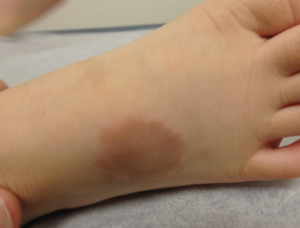Chapter 10: Inflammatory Skin Conditions
Granuloma Annulare
What is it?
Granuloma annulare is an inflammatory condition of unknown cause. It most frequently affects patient younger than 30 and is twice as common in women.
What does it look like?
Granuloma annulare may be localized or generalized. It presents as annular red to brown plaques with central clearing and no scale. It often occurs on the extremities, especially the hands, feet, elbows and ankles. It may be itchy or asymptomatic.

How is it managed?
Granuloma annulare is a benign condition and resolves without treatment within a few months to years. Topical or intralesional steroids can be used. Other options include topical calcineurin inhibitors, phototherapy, systemic retinoids, dapsone and hydroxychloroquine.
What is the differential diagnosis?
Granuloma annulare is frequently misdiagnosed as tinea corporis (ringworm). The key distinguishing feature is the lack of scale in granuloma annulare. If needed, KOH prep can be attempted to look for the presence of fungi.

